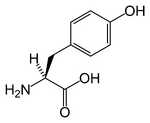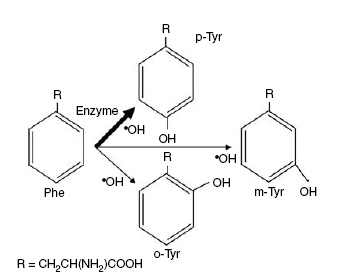Assessment |
Biopsychology |
Comparative |
Cognitive |
Developmental |
Language |
Individual differences |
Personality |
Philosophy |
Social |
Methods |
Statistics |
Clinical |
Educational |
Industrial |
Professional items |
World psychology |
Biological: Behavioural genetics · Evolutionary psychology · Neuroanatomy · Neurochemistry · Neuroendocrinology · Neuroscience · Psychoneuroimmunology · Physiological Psychology · Psychopharmacology (Index, Outline)
| Tyrosine | |
|---|---|
 
| |
| Systematic name | (S)-2-Amino-3-(4-hydroxy- phenyl)-propanoic acid |
| Abbreviations | Tyr Y |
| Chemical formula | C9H11NO3 |
| Molecular mass | 181.19 g mol-1 |
| Melting point | 343 °C |
| Density | 1.456 g cm-3 |
| Isoelectric point | 5.66 |
| pKa | 2.24 9.04 10.10 |
| Molar extinction coefficient | 1420 M-1 cm-1 at 274.6 nm |
| CAS number | [60-18-4] |
| EINECS number | 200-460-4 |
| SMILES | Oc1ccc(CC(N)C(=O)O)cc1 |
| Absoption and emission spectrum Absorption (blue) and fluorescence (red) of tyrosine in water (pH 7) | |
| Disclaimer and references | |
Tyrosine (from the Greek tyros, meaning cheese, as it was first discovered in 1846 by German chemist Justus von Liebig in cheese[1][2]), 4-hydroxyphenylalanine, or 2-amino-3(4-hydroxyphenyl)-propanoic acid, is one of the 20 amino acids that are used by cells to synthesize proteins. It has a phenol side chain with a hydroxyl group. Upon the location of the hydroxyl group, there are three structural isomers of Tyr, namely para-Tyr (p-Tyr), meta-Tyr (m-Tyr) and ortho-Tyr (o-Tyr). Enzymatically, only the first isomer (p-Tyr) is produced from L-Phe by the Phe-hydroxylase enzyme. The other two isoforms, m-Tyr and o-Tyr can be produced as a consequence of free radical attack on Phe in states with increased oxidative stress.
Tyrosine is abundant in insulin as well as the enzyme papain
Meat, dairy, eggs as well as almonds, avocados and bananas are good sources of this nutrient.
Biosynthesis[]
Tyrosine cannot be completely synthesized by animals but it may be regarded as a nonessential amino acid in humans as it can be synthesised by hydroxylation of phenylalanine if the latter is in abundant supply.
It is produced by plants and most microorganisms from prephenate, an intermediate on the shikimate pathway.
Prephenate is oxidatively decarboxylated with retention of the hydroxyl group to give p-hydroxyphenylpyruvate. This is transaminated using glutamate as the nitrogen source to give tyrosine and α-ketoglutarate.
Tyrosine hydroxylase[]
Tyrosine hydroxylase (TH) is the rate-limiting enzyme involved in the synthesis of the catecholamines such as dopamine, norepinephrine and epinephrine.
Role[]
Precuror of adrenaline, noradrenaline and dopmine[]
Tyrosine is converted to DOPA in the adrenal medulla by tyrosine hydroxylase, an enzyme . Composed mainly of hormone-producing chromaffin cells, the adrenal medulla is the principal site of the conversion of the amino acid tyrosine into the catecholamines adrenaline (epinephrine), noradrenaline (norepinephrine), and dopamine.
Some of the tyrosine residues can be tagged with a phosphate group (phosphorylated) by protein kinases. (In its phosphorylated state, it is referred to as phosphotyrosine.). Tyrosine phosphorylation is considered as one of the key steps in signal transduction and regulation of enzymatic activity. Phosphotyrosine can be detected through specific antibodies.
Precursor of thyroid hormone[]
Tyrosine is also precursor to the thyroid hormones thyroxine and triiodothyronine, the pigment melanin, and the biologically-active catecholamines dopamine, norepinephrine and epinephrine.
Precursor of melanin[]
In addition to its role in proteins, tyrosine is the precursor for the synthesis of melanin (the black and brown pigment of skin and hair),
Other[]
In Papaver somniferum, the opium poppy, it is used to produce morphine.
Medical use[]
L-Tyrosine is sometimes recommended by practitioners as helpful for weight loss, clinical depression, Parkinson's Disease , and phenylketonuria;
One study found that it had no impact on endurance exercise performance.[3]
See also[]
References[]
- GA Molnar et al. Kidney International 68:2281-2287, 2005 Abstract
- GA Molnar et al. Free Radical Research 39(12):1359-1366, 2005 Abstract
Notes[]
- ↑ Tyrosine at infoplease.com
- ↑ Tyrosine at etymonline.com
- ↑ Parcell A.C., et al. Effects of L-tyrosine and carbohydrate ingestion on performance. Journal of Applied Physiology 2002 Nov; 93(5): 1590-97. Abstract
External links[]
- Phenylalanine and tyrosine biosynthesis
- Computational Chemistry Wiki
- Phosphotyrosine Antibody
- Link page to external chemical sources.
| Alanine | Arginine | Asparagine | Aspartic acid | Cysteine | Glutamic acid | Glutamine | Glycine | Histidine | Isoleucine | Leucine | Lysine | Methionine | Phenylalanine | Proline | Serine | Threonine | Tryptophan | Tyrosine | Valine |
| Essential amino acid | Protein | Peptide | Genetic code |
| This page uses Creative Commons Licensed content from Wikipedia (view authors). |

